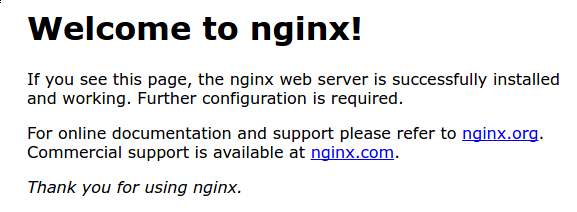- Log in to:
- Community
- DigitalOcean
- Sign up for:
- Community
- DigitalOcean
Not using Ubuntu 16.04?
Choose a different version or distribution.
Introduction
Nginx is one of the most popular web servers in the world and is responsible for hosting some of the largest and highest-traffic sites on the internet. It is more resource-friendly than Apache in most cases and can be used as a web server or a reverse proxy.
In this guide, we’ll discuss how to get Nginx installed on your Ubuntu 16.04 server.
Prerequisites
Before you begin this guide, you should have a regular, non-root user with sudo privileges configured on your server. You can learn how to configure a regular user account by following our initial server setup guide for Ubuntu 16.04.
When you have an account available, log in as your non-root user to begin.
Step 1: Install Nginx
Nginx is available in Ubuntu’s default repositories, so the installation is rather straight forward.
Since this is our first interaction with the apt packaging system in this session, we will update our local package index so that we have access to the most recent package listings. Afterwards, we can install nginx:
- sudo apt-get update
- sudo apt-get install nginx
After accepting the procedure, apt-get will install Nginx and any required dependencies to your server.
Step 2: Adjust the Firewall
Before we can test Nginx, we need to reconfigure our firewall software to allow access to the service. Nginx registers itself as a service with ufw, our firewall, upon installation. This makes it rather easy to allow Nginx access.
We can list the applications configurations that ufw knows how to work with by typing:
- sudo ufw app list
You should get a listing of the application profiles:
OutputAvailable applications:
Nginx Full
Nginx HTTP
Nginx HTTPS
OpenSSH
As you can see, there are three profiles available for Nginx:
- Nginx Full: This profile opens both port 80 (normal, unencrypted web traffic) and port 443 (TLS/SSL encrypted traffic)
- Nginx HTTP: This profile opens only port 80 (normal, unencrypted web traffic)
- Nginx HTTPS: This profile opens only port 443 (TLS/SSL encrypted traffic)
It is recommended that you enable the most restrictive profile that will still allow the traffic you’ve configured. Since we haven’t configured SSL for our server yet, in this guide, we will only need to allow traffic on port 80.
You can enable this by typing:
- sudo ufw allow 'Nginx HTTP'
You can verify the change by typing:
- sudo ufw status
You should see HTTP traffic allowed in the displayed output:
OutputStatus: active
To Action From
-- ------ ----
OpenSSH ALLOW Anywhere
Nginx HTTP ALLOW Anywhere
OpenSSH (v6) ALLOW Anywhere (v6)
Nginx HTTP (v6) ALLOW Anywhere (v6)
Step 3: Check your Web Server
At the end of the installation process, Ubuntu 16.04 starts Nginx. The web server should already be up and running.
We can check with the systemd init system to make sure the service is running by typing:
- systemctl status nginx
Output● nginx.service - A high performance web server and a reverse proxy server
Loaded: loaded (/lib/systemd/system/nginx.service; enabled; vendor preset: enabled)
Active: active (running) since Mon 2016-04-18 16:14:00 EDT; 4min 2s ago
Main PID: 12857 (nginx)
CGroup: /system.slice/nginx.service
├─12857 nginx: master process /usr/sbin/nginx -g daemon on; master_process on
└─12858 nginx: worker process
As you can see above, the service appears to have started successfully. However, the best way to test this is to actually request a page from Nginx.
You can access the default Nginx landing page to confirm that the software is running properly. You can access this through your server’s domain name or IP address.
If you do not have a domain name set up for your server, you can learn how to set up a domain with DigitalOcean here.
If you do not want to set up a domain name for your server, you can use your server’s public IP address. If you do not know your server’s IP address, you can get it a few different ways from the command line.
Try typing this at your server’s command prompt:
- ip addr show eth0 | grep inet | awk '{ print $2; }' | sed 's/\/.*$//'
You will get back a few lines. You can try each in your web browser to see if they work.
An alternative is typing this, which should give you your public IP address as seen from another location on the internet:
- sudo apt-get install curl
- curl -4 icanhazip.com
When you have your server’s IP address or domain, enter it into your browser’s address bar:
http://server_domain_or_IP
You should see the default Nginx landing page, which should look something like this:

This page is simply included with Nginx to show you that the server is running correctly.
Step 4: Manage the Nginx Process
Now that you have your web server up and running, we can go over some basic management commands.
To stop your web server, you can type:
- sudo systemctl stop nginx
To start the web server when it is stopped, type:
- sudo systemctl start nginx
To stop and then start the service again, type:
- sudo systemctl restart nginx
If you are simply making configuration changes, Nginx can often reload without dropping connections. To do this, this command can be used:
- sudo systemctl reload nginx
By default, Nginx is configured to start automatically when the server boots. If this is not what you want, you can disable this behavior by typing:
- sudo systemctl disable nginx
To re-enable the service to start up at boot, you can type:
- sudo systemctl enable nginx
Step 5: Get Familiar with Important Nginx Files and Directories
Now that you know how to manage the service itself, you should take a few minutes to familiarize yourself with a few important directories and files.
Content
/var/www/html: The actual web content, which by default only consists of the default Nginx page you saw earlier, is served out of the/var/www/htmldirectory. This can be changed by altering Nginx configuration files.
Server Configuration
/etc/nginx: The Nginx configuration directory. All of the Nginx configuration files reside here./etc/nginx/nginx.conf: The main Nginx configuration file. This can be modified to make changes to the Nginx global configuration./etc/nginx/sites-available/: The directory where per-site “server blocks” can be stored. Nginx will not use the configuration files found in this directory unless they are linked to thesites-enableddirectory (see below). Typically, all server block configuration is done in this directory, and then enabled by linking to the other directory./etc/nginx/sites-enabled/: The directory where enabled per-site “server blocks” are stored. Typically, these are created by linking to configuration files found in thesites-availabledirectory./etc/nginx/snippets: This directory contains configuration fragments that can be included elsewhere in the Nginx configuration. Potentially repeatable configuration segments are good candidates for refactoring into snippets.
Server Logs
/var/log/nginx/access.log: Every request to your web server is recorded in this log file unless Nginx is configured to do otherwise./var/log/nginx/error.log: Any Nginx errors will be recorded in this log.
Conclusion
Now that you have your web server installed, you have many options for the type of content to serve and the technologies you want to use to create a richer experience.
Learn how to use Nginx server blocks here. If you’d like to build out a more complete application stack, check out this article on how to configure a LEMP stack on Ubuntu 16.04.
Thanks for learning with the DigitalOcean Community. Check out our offerings for compute, storage, networking, and managed databases.
About the author
Former Senior Technical Writer at DigitalOcean, specializing in DevOps topics across multiple Linux distributions, including Ubuntu 18.04, 20.04, 22.04, as well as Debian 10 and 11.
Still looking for an answer?
This textbox defaults to using Markdown to format your answer.
You can type !ref in this text area to quickly search our full set of tutorials, documentation & marketplace offerings and insert the link!
Thanks for the tutorial! I followed all the tutorials for setting up a new Ubuntu 16.04 droplet, securing it and installing the LEMP stack. Everything is up and running however I have a practical question.
I am using Dreamweaver to manage files the server. I can connect to the server in Dreamweaver and see the files on the server. However, I am unable to upload to the server. I know the problem is due to permission issues but I don’t know the best way to resolve the problem.
Here are some points that may be important:
- The /var/www/html directory is owned by root:root
- Nginx uses the default user www-data
- My user is configured with sudo access
- As instructed in one of the tutorials, users can’t login to the server with a password so it is configured to use an RSA key
Thank you in advance.
Just upgraded to 16.04 from 14.04 following this https://www.digitalocean.com/community/tutorials/how-to-upgrade-to-ubuntu-16-04-lts
Had issues with installing nginx so I removed nginx and reinstalled, but now when I run status i’m getting an error:
$ sudo systemctl status nginx
Failed to get properties: No such interface ''
This comment has been deleted
Hi Justin, please update the server blocks link at the bottom of the article, it’s linking to article using Ubuntu v14, but there’s another, Ubuntu v16 article.
Following this tutorial I have NGINX running and be able to restart the service from my non root user using
sudo service nginx restart
However there seems to be a race between systemd and nginx as the service status informs me that it failed to read PID from file /run/nginx.pid: Invalid argument. As if systemd was expecting the PID file to be populated before nginx had the time to create it. As a work around I create this file:
/etc/systemd/system/nginx.service.d/override.conf
With following content:
[Service]
ExecStartPost=/bin/sleep 0.1
Therafter I need to reload the daemon.
systemctl daemon-reload
This resolves the problem. The service will now wait a moment which is enough for the PID file to be populated.
I have Apache web server already installed in droplet which is used to serve html/php based websites, but for now I need to deploy a NodeJs app, so that I think I need to go with nGinx ? How can it be done ? can both be installed at one droplet, how ?
Thanks
- Table of contents
- Prerequisites
- Step 1: Install Nginx
- Step 2: Adjust the Firewall
- Step 3: Check your Web Server
- Step 4: Manage the Nginx Process
- Step 5: Get Familiar with Important Nginx Files and Directories
- Conclusion
Deploy on DigitalOcean
Click below to sign up for DigitalOcean's virtual machines, Databases, and AIML products.
Become a contributor for community
Get paid to write technical tutorials and select a tech-focused charity to receive a matching donation.
DigitalOcean Documentation
Full documentation for every DigitalOcean product.
Resources for startups and SMBs
The Wave has everything you need to know about building a business, from raising funding to marketing your product.
Get our newsletter
Stay up to date by signing up for DigitalOcean’s Infrastructure as a Newsletter.
New accounts only. By submitting your email you agree to our Privacy Policy
The developer cloud
Scale up as you grow — whether you're running one virtual machine or ten thousand.
Get started for free
Sign up and get $200 in credit for your first 60 days with DigitalOcean.*
*This promotional offer applies to new accounts only.
